Jean Hippolyte Flandrin (1809-1864) was a Neo-Classical painter whose work tends to lack the sensuality of his master, Ingres, yet who managed to produce one picture at least which has been an inspiration to subsequent artists and photographers.
Jeune Homme Assis au Bord de la Mer (Young Man Sitting by the Seashore) was painted in 1836. The simplicity and directness of the rendering is probably intended to be reminiscent of Classical sculpture and the figures seen on Greek pottery and bas-reliefs. There’s nothing in Flandrin’s history to suggest a homoerotic intent but the picture has that effect nonetheless, and it’s to gay artists (and viewers) that the work has mostly appealed since, as can be seen below.
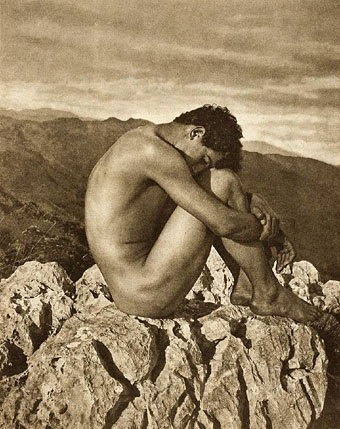
The first (?) copy, usually dated as being from 1900 although it may be earlier, and a very careful imitation of the original pose. Photographer Wilhelm von Gloeden specialised in Classical-themed gay erotica and gave his figure a Biblical allusion by titling the picture Cain. Gloeden’s follower, Gaetano d’Agata, produced his own version.
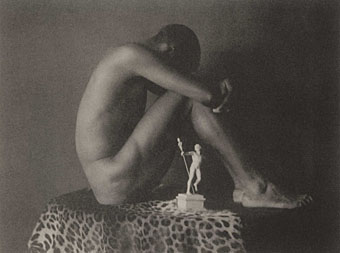
Ebony and Ivory (1897) by Fred Holland Day.
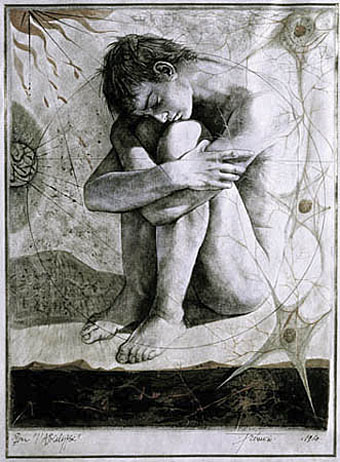
L’Apocalypse by Pierre Yves Trémois (1961).

Ajitto by Robert Mapplethorpe (1981).
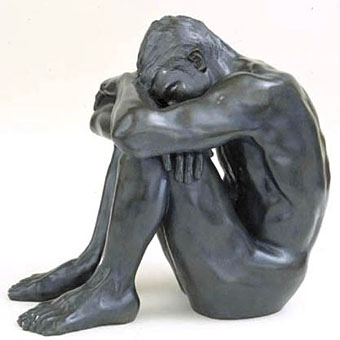
A rare sculpture version, L’Homme de l’Apocalypse by Pierre Yves Trémois (1998).
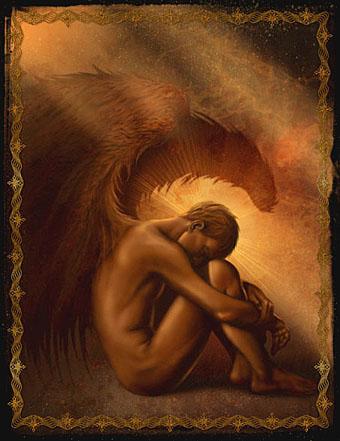
Finally, here’s my own Fallen Angel picture from 2004 which added wings to the figure.
Elsewhere on { feuilleton }
• The recurrent pose archive
• The gay artists archive

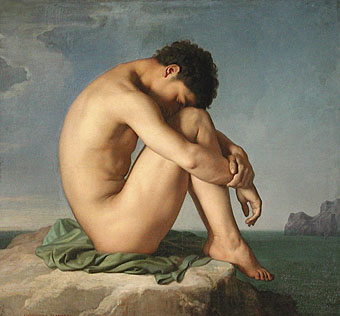
c’mon then:
http://www.unshod.org/pfbc/mpstars.jpg
http://www.angelfire.com/ny5/missionguild/MaxfieldParrishMidSummerPrintWeb2002.jpg
Ah yeah, good old Maxfield. The stars one definitely seems like it might derive from Flandrin’s original.
See Eddie Campbell’s recent post
JC traces the evolution of a single pose in the work of French neoclassical painter Jean Hippolyte Flandrin (1809-1864) through six examples as it becomes a popular icon. Norman Hathaway responds to the post with a couple more, and John himself comes back with another on the 19th. I’ve always wondered what Paul Gulacy was referencing (duh!) on this old Miracleman cover (sorry to bring the tone down).
****
Image:
http://bp0.blogger.com/_PeV5Fgv9e7A/Rdoi22GJndI/AAAAAAAABDg/KeYepg7XlKU/s1600-h/3080_2_05.jpg
whoops forgot the date of the post 20th February
Yes thanks, spotted that and left a comment.
its fabulous..
more men shud b in
its really lovely n so charming, hope more men gonna make it
Wasn’t there a scene in “There Will be Blood” that recreated this pose by the seashore? That was my first thought.
Hi David. I remember that scene on the beach but don’t recall exactly how it was directed. I’d guess if there was a similarity it’s probably a result of coincidence but it’s worth looking for next time I watch the film.
a woman should do it and then everyone will explode from the scandal
If Flandrin was “Neo” Classical, he’s riffing on a Classical pose, right? I feel like I should dig out old art history books; this posture did not start in the 19th century. Before that, it started in the womb. It is the original pose of everyone.
Saw “There Will Be Blood” for the first time a couple of days ago and as soon as I saw the beach scene I though of the Flandrin painting. Don’t know much about the painting, but feels like it couldn’t be coincidence.